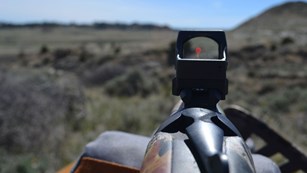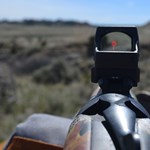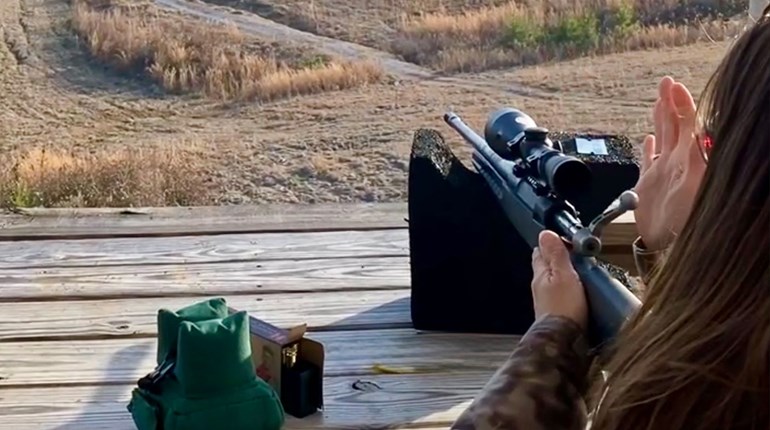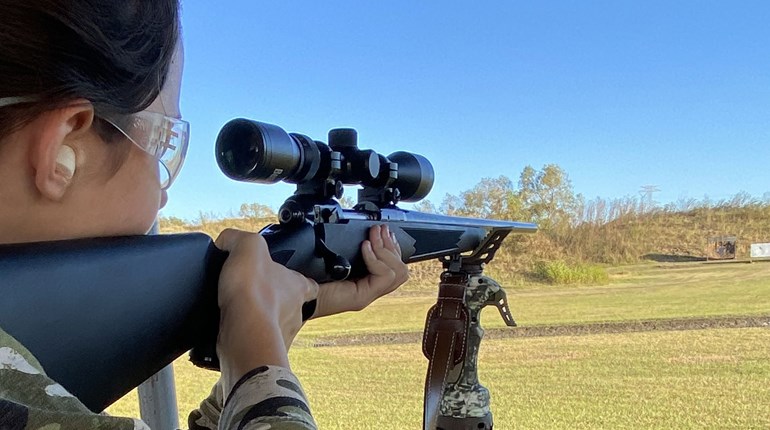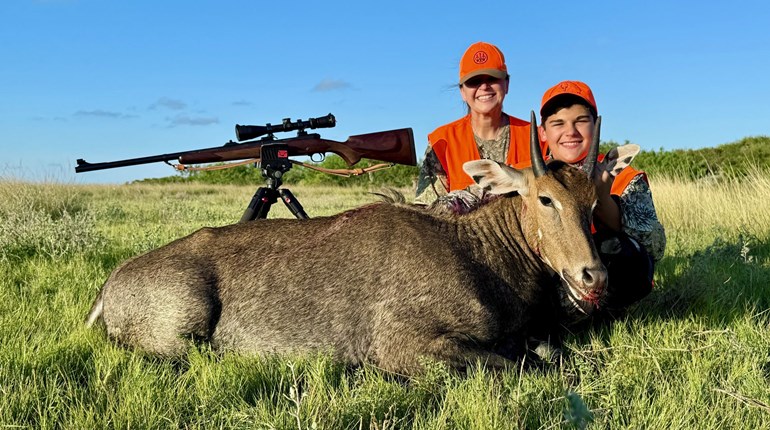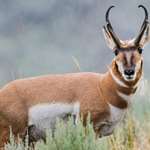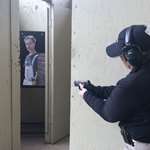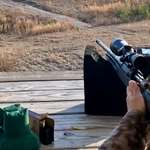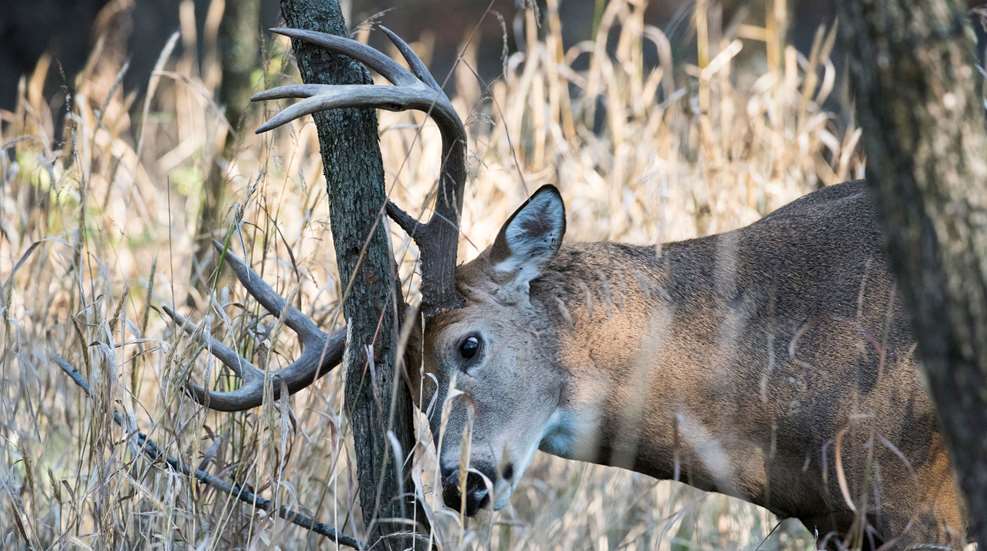
The number of women who hunt is increasing every year. More and more women are venturing into the field of deer hunting alone, or with the companionship of other lady hunters. Individuals who are new to the hunting world or trying deer hunting for the first time should do their best to “scout” the area they are planning to hunt.

Scouting the hunting area ahead of time is important for a successful hunt. It is also important to scout the area that you are hunting to help you understand the game you are pursuing. There are six signs that deer hunters need to know when scouting the area they are planning to hunt: tracks, scrapes, rubs, scat, bedding areas, and the deer themselves.
Tracks
Deer tracks are the imprints that are left in the ground by the hooves of deer. White-tailed deer tracks can be up to four inches long and up to three inches wide. They are cloven, meaning there are two distinct “lobes” that resemble arched teardrops with the rearward end being rounded and the forward end being pointed. Many times, the dew claw marks can be seen approximately ½-inch from the rear of the track.

Bucks usually have larger tracks than does. Buck tracks are also usually deeper than the doe tracks. Deer tracks are a good indication of the number of deer on the property. They can also be used to lead a hunter who is out scouting, the direction to food plots and bedding areas.
Deer are creatures of habit, and they seem to always look for the easiest travel route that affords them the most security. This means that if you locate an abundance of deer tracks, chances are very good that you will have success hunting the area.
Scrapes
Scrapes are made by buck deer during the “rut” or breeding season to attract does. Scrapes are made by the buck deer using its front hooves to scrape the ground bare of leaves, grass, and other vegetation to expose a round, oval, or sometimes even a triangle area. Once the scrape is made, the buck urinates on the bare ground. The urine contains hormones that attract does looking for a mate. The buck also urinates so that it runs down his back legs. This allows this urine to flow over the rear hock glands of the buck to add more scent.

Scrapes can be made in the open area under a tree with low-hanging limbs. If the buck makes a scrape under a tree, it is looking to add other scents to attract a doe. The buck will often lick twigs and the ends of branches. He will also rub the ends of these twigs and branches on the inside of its nostrils.
Most of the scent left behind on twigs and branches comes from gland ducts found in the corner of the buck’s eyes. The buck will gently dig the ends of the twigs into these glands to leave additional hormone scents. Since these scents are left up to six feet off the ground, this attractant is taken with the breeze to cover large areas.
Rubs
Rubs are a great way of determining if buck deer are in the area you are hunting. After deer shed their antlers, small buds begin growing between the buck’s ears around late spring. As the antlers develop, they are covered with blood vessels, skin, and short hair known as velvet, which supplies nutrients and minerals to the growing bone. When antlers reach their full size in the fall, the velvet is no longer needed. The buck rubs his antlers against trees and shrubs to remove this thin layer that may still be attached to the antlers, exposing the hard and shiny bone. Rubs are made when the buck rubs the main beans and tines of the antlers to remove any “velvet” that may still be attached.

Small trees and saplings that have been rubbed by a buck deer will have visual signs such as slick areas where the bark has been removed. There can also be strips of dried velvet hanging from the areas that have been rubbed. When bucks rub, this leaves scent markers on the trees in the buck’s home range that lets does know they are in his domain. Head rubs can be identified by broken twigs or small limbs near the trunk. The buck’s hair can often be found in the bark of the tree.
Scat
Deer scat is one of the best ways to determine if deer are considering sticking around your hunting grounds. Scat is also known as droppings or feces. Other signs such as tracks give away that deer are in the area, but there is no way of knowing if the game is just passing through or if they are on the extreme ends of their home range. Deer need food, and the presence of scat indicates that there is a good nutrition source available. It is also true that as long as there is a good nutrition source available, deer will stay nearby.

Deer scat is about the size of an almond and is usually oval or slightly more pointed at one end. It is usually dark brown or black but can vary to lighter shades depending on the deer’s diet. These “pellets” can be found scattered along the ground or found in clumps. Deer are ruminants, meaning they eat plants and other vegetation. More precisely, deer survive on browse and forbs.
Browse consists of leaves, twigs, buds, or other types of vegetation that are found higher than ground level. Forbs consists of flowers and parts of flowering plants that grow along the ground. If you find a lot of deer scat in a certain area, it is easy to determine what the animal is feeding on by looking at the surrounding vegetation.
Bedding Areas
Locating deer bedding areas is a good way to improve your success when deer hunting. Deer bedding areas are often found in thickets or areas of dense growth of bushes or trees. These areas often have tall grass or other types of vegetation that give the deer a sense of security.

You can find bedding areas by looking for dense vegetation, especially on game trails leading to or leaving food plots. The bedding areas can be identified by an area of pushed-down grass or other vegetation that is laid over in thick cover. Bedding areas are often hidden from view by bushes or other geographical features.
Bedding areas are hunted by ambushing deer. When hunting, find a good spot on the game trail to wait for the deer when it is leaving the bedding area or returning to it after feeding. In the morning, the deer will be leaving the bedding area to feed. In the afternoon, the deer will return to the bedding area after it feeds.

Deer
Seeing deer is the most proof-positive way of telling if there are deer on the land you are hunting. By driving through the area, a hunter can usually see if there are deer present because he or she will get the familiar “white flag” also known as the tail flip. When you drive through your hunting area ahead of the day you plan to hunt, you are taking an informal deer “census” or count.
Conducting a deer count after dark is one of the methods that biologists and land managers use to obtain fairly accurate numbers on the deer population. If permitted by your local game laws and the landowner or agent, driving the area at night with a spotlight is a great way of gaining some knowledge of the population of the deer on the property you are planning to hunt. If you are allowed to conduct a night deer census, never have a firearm in the vehicle with you. You do not want to be confused with a night hunter or poacher. It is also a good idea to let the local game warden know ahead of time what you are doing.
By knowing the signs, you are on your way to becoming an experienced and knowledgeable deer hunter. Success often leads to an activity becoming a hobby and this includes hunting. The number of women entering the field every year proves this. Be sure to purchase a valid hunting license in the state you are hunting and enroll in and take a Hunter Education course. For additional information regarding hunting and firearm safety, you can also take the NRA Hunter Education course. Good luck and happy hunting!










